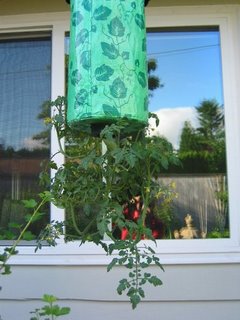
This is the first fig tree that I attempted to grow. It was purchased from a mail order catalog and was about 6 inches tall, in 2001. I didn't know anything about growing figs, but as a midwestern native, the thought that one might grow in my yard seems exotic and interesting.
This tree has grown about 1 foot per yer, so now it's about 5 1/2 feet tall. Last year it bore about a dozen main crop (fall crop, which forms on this year's growth) figs. During the Winter, it was mulched wtih several inches of leaves; then in the Spring a couple of inches of leaf compost were added. It also received generous amounts of coffee grounds, and crushed eggshells (that, when added to the grouns, look a bit like perlite).
This year, it looks like it will reward these offerings with a couple of handfuls of breba (summer crop, which form on last year's growth) figs. Now it also has a layer of bark mulch to keep the roots moist and cool. It has produced about 1 foot of new growth, which I pinched back after the 4th to 6th new leaf, to encourage fig production and shape the tree compactly. The tree is starting to respond with tiny, embryonic figs and buds that I dont know yet if they will be new stems or figs.
Figs have an amazing biological, geographic, botanical, and social history. Apparently they originate in western Asia, and have been carried by various civilizations westward and eastward, so that now they grow in all mild temperate areas of the world. They are under-appreciated, because the fruits don't keep well enough to ship long distances, and they dont ripen after being picked. They are best eaten fresh, right off the tree or in 1 to 2 days. Most people dont know when to pick them, so it takes some guidance to learn when they will be at their peak, and most tasty.
As small trees, figs in the yard dont require chemical fertilizers, pesticides, or herbicides. They require little maintenance, although careful grooming will keep them more compact. Once planted, the garden doesn't need to be dug up again. It seems like they could be ideal as edible landscaping, and their net effect on the environment is to improve it. By taking care of the fig trees, they improve our environment and nourish us with exotic fruits. They are a link to our own history, and can be a heritage that we leave to those who care to follow.
I didnt know it when I started this first fig, but fig trees are usually grown from cuttings. Many varieties grow very quickly using this method, nbearing fruit in 1 to 3 years. It's very similar to the method for starting grapes. There are many variations of the method, but some will start from dormant prunings, kept in a platic bag in the refridgerator over the winter, and planted in moist garden soil in the early Spring. Faster growth occurs by using a similar method, but starting them indoors during the Winter. I've started about 1 dozen new fig trees using this method, and it is a way to pass them on to friends, neighbors, or relatives.

 These were started last year without much effort. The seeds were collected in Fall 2004. They were kept in the fridge over the winter and planted in containers that had other things growing (like tomatoes and peppers) so that they did not need individual attention. Only about 1/2 of them survived the winter - something ate the others. Some people are more scientific about starting ginkgos from seeds. I did the same this winter. The seeds looked a bit moldy so if they grow it will be a surprise - but last year's were a surprise as well.
These were started last year without much effort. The seeds were collected in Fall 2004. They were kept in the fridge over the winter and planted in containers that had other things growing (like tomatoes and peppers) so that they did not need individual attention. Only about 1/2 of them survived the winter - something ate the others. Some people are more scientific about starting ginkgos from seeds. I did the same this winter. The seeds looked a bit moldy so if they grow it will be a surprise - but last year's were a surprise as well. 















